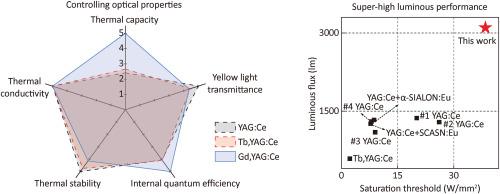Laser-driven composite ceramic enabling superhigh-luminance white light
IF 9.6
1区 材料科学
Q1 CHEMISTRY, PHYSICAL
引用次数: 0
Abstract
Laser-remote activated phosphor (LARP) converted solid state lighting is now developing towards high power density and super-brightness, and phosphor ceramic converters with high efficiency, high thermal conductivity, acceptable transmittance and suitable spectra are thus required. Y3Al5O12:Ce (YAG:Ce)-based ceramics are promising color converters to produce white light with a color temperature of 6000 K for vehicle headlamps, but the brightness and luminous efficiency are not well optimized. In this work, two series of Al2O3-YAG:Ce and Al2O3-(Gd,Y)AG:Ce transparent ceramics were fabricated by vacuum sintering, and their microstructure, thermal and optical properties were controlled by changing the Ce3+ or Al2O3 content as well the thickness of the ceramics. Both Al2O3![]() Y2.925Al5O12:Ce0.0175 (AY0.0175) and Al2O3-(Gd0.1Y2.89)Al5O12:Ce0.01 (AGY) ceramics containing 70% (in mass) Al2O3 show a luminance saturation threshold of 30.3 W/mm2 and 38.4 W/mm2, enabling to produce white light with a color temperature of 6000 K, luminous flux of 1928 lm and 3101 lm, luminous efficiency of 135.0 lm/W and 161.1 lm/W when pumped by blue laser diodes, respectively. This work provides a solution to finely control the composition, microstructure, and optical properties of transparent ceramics for super-high brightness laser-driven solid-state lighting.
Y2.925Al5O12:Ce0.0175 (AY0.0175) and Al2O3-(Gd0.1Y2.89)Al5O12:Ce0.01 (AGY) ceramics containing 70% (in mass) Al2O3 show a luminance saturation threshold of 30.3 W/mm2 and 38.4 W/mm2, enabling to produce white light with a color temperature of 6000 K, luminous flux of 1928 lm and 3101 lm, luminous efficiency of 135.0 lm/W and 161.1 lm/W when pumped by blue laser diodes, respectively. This work provides a solution to finely control the composition, microstructure, and optical properties of transparent ceramics for super-high brightness laser-driven solid-state lighting.


激光驱动复合陶瓷实现超高亮度白光
激光远激活荧光粉(LARP)转换固态照明正朝着高功率密度和超亮度方向发展,因此需要具有高效率、高导热性、可接受的透过率和合适光谱的荧光粉陶瓷转换器。Y3Al5O12:Ce (YAG:Ce)基陶瓷是一种很有前途的颜色转换器,可以产生色温为6000 K的白光,用于汽车前照灯,但亮度和发光效率没有得到很好的优化。本文采用真空烧结法制备了Al2O3- yag:Ce和Al2O3-(Gd,Y)AG:Ce两系列透明陶瓷,通过改变陶瓷的Ce3+或Al2O3含量以及陶瓷的厚度来控制其显微结构、热性能和光学性能。含有70%(质量)Al2O3的Al2O3- y2.925 Al5O12:Ce0.0175 (AY0.0175)和Al2O3-(Gd0.1Y2.89)Al5O12:Ce0.01 (AGY)陶瓷的亮度饱和阈值分别为30.3 W/mm2和38.4 W/mm2,在蓝色激光二极管泵浦下可产生色温为6000 K的白光,光通量分别为1928 lm和3101 lm,发光效率分别为135.0 lm/W和161.1 lm/W。这项工作提供了一种解决方案,可以精细地控制透明陶瓷的组成、微观结构和光学性能,用于超高亮度激光驱动的固态照明。
本文章由计算机程序翻译,如有差异,请以英文原文为准。
求助全文
约1分钟内获得全文
求助全文
来源期刊

Journal of Materiomics
Materials Science-Metals and Alloys
CiteScore
14.30
自引率
6.40%
发文量
331
审稿时长
37 days
期刊介绍:
The Journal of Materiomics is a peer-reviewed open-access journal that aims to serve as a forum for the continuous dissemination of research within the field of materials science. It particularly emphasizes systematic studies on the relationships between composition, processing, structure, property, and performance of advanced materials. The journal is supported by the Chinese Ceramic Society and is indexed in SCIE and Scopus. It is commonly referred to as J Materiomics.
 求助内容:
求助内容: 应助结果提醒方式:
应助结果提醒方式:


